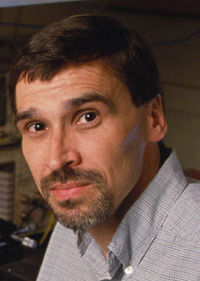Home > Press > Seabaugh to Receive 2011 Quantum Devices Award
 |
| Alan C. Seabaugh |
Abstract:
Alan C. Seabaugh, professor of electrical engineering, Frank M. Freimann Director of the Midwest Institute for Nanoelectronics Discovery (MIND) and associate director of the Center for Nano Science and Technology, has been named the recipient of the 2011 Quantum Devices Award by the International Symposium on Compound Semiconductors. Scheduled to be presented in May in Berlin during the 38th symposium, the award honors "pioneering contributions to the field of compound semiconductor devices and quantum nanostructure devices."
Seabaugh to Receive 2011 Quantum Devices Award
Notre Dame, IN | Posted on April 16th, 2011Seabaugh was recognized for "seminal contributions and leadership in semiconductor devices and circuits based on quantum mechanical tunneling such as tunnel field-effect transistors and resonant tunneling transistors." This work is particularly important as it affects how electronic devices could be developed in the future … including their size, speed and energy efficiency.
For more than a quarter century Seabaugh has been active in the field of high-speed devices, where his efforts have spanned both industry and academia. His research explores the physical limits of electronic materials devices and circuits with applications in computing, communications, imaging and energy conversion.
A fellow of the IEEE, Seabaugh also is editor for the IEEE Transactions on Electron Devices and a member of the American Physical Society. He has authored and co-authored more than 200 publications, including three book chapters, and is the holder of 22 patents.
Prior to joining the University in 1999, he served as a senior fellow at Raytheon Systems Company, distinguished member of the technical staff at Texas Instruments and electronics engineer at the National Bureau of Standards.
Seabaugh received his bachelor's, master's and doctoral degrees in electrical engineering from the University of Virginia.
####
For more information, please click here
Contacts:
405 Main Building
Notre Dame, IN 46556
Phone: (574) 631-7367
Fax: (574) 631-4311
Copyright © University of Notre Dame
If you have a comment, please Contact us.Issuers of news releases, not 7th Wave, Inc. or Nanotechnology Now, are solely responsible for the accuracy of the content.
| Related News Press |
News and information
![]() Researchers develop molecular qubits that communicate at telecom frequencies October 3rd, 2025
Researchers develop molecular qubits that communicate at telecom frequencies October 3rd, 2025
![]() Next-generation quantum communication October 3rd, 2025
Next-generation quantum communication October 3rd, 2025
![]() "Nanoreactor" cage uses visible light for catalytic and ultra-selective cross-cycloadditions October 3rd, 2025
"Nanoreactor" cage uses visible light for catalytic and ultra-selective cross-cycloadditions October 3rd, 2025
Chip Technology
![]() Lab to industry: InSe wafer-scale breakthrough for future electronics August 8th, 2025
Lab to industry: InSe wafer-scale breakthrough for future electronics August 8th, 2025
![]() A 1960s idea inspires NBI researchers to study hitherto inaccessible quantum states June 6th, 2025
A 1960s idea inspires NBI researchers to study hitherto inaccessible quantum states June 6th, 2025
![]() Programmable electron-induced color router array May 14th, 2025
Programmable electron-induced color router array May 14th, 2025
Announcements
![]() Rice membrane extracts lithium from brines with greater speed, less waste October 3rd, 2025
Rice membrane extracts lithium from brines with greater speed, less waste October 3rd, 2025
![]() Researchers develop molecular qubits that communicate at telecom frequencies October 3rd, 2025
Researchers develop molecular qubits that communicate at telecom frequencies October 3rd, 2025
![]() Next-generation quantum communication October 3rd, 2025
Next-generation quantum communication October 3rd, 2025
![]() "Nanoreactor" cage uses visible light for catalytic and ultra-selective cross-cycloadditions October 3rd, 2025
"Nanoreactor" cage uses visible light for catalytic and ultra-selective cross-cycloadditions October 3rd, 2025
Events/Classes
![]() Institute for Nanoscience hosts annual proposal planning meeting May 16th, 2025
Institute for Nanoscience hosts annual proposal planning meeting May 16th, 2025
![]() A New Blue: Mysterious origin of the ribbontail ray’s electric blue spots revealed July 5th, 2024
A New Blue: Mysterious origin of the ribbontail ray’s electric blue spots revealed July 5th, 2024
![]() Researchers demonstrate co-propagation of quantum and classical signals: Study shows that quantum encryption can be implemented in existing fiber networks January 20th, 2023
Researchers demonstrate co-propagation of quantum and classical signals: Study shows that quantum encryption can be implemented in existing fiber networks January 20th, 2023
Grants/Sponsored Research/Awards/Scholarships/Gifts/Contests/Honors/Records
![]() Researchers tackle the memory bottleneck stalling quantum computing October 3rd, 2025
Researchers tackle the memory bottleneck stalling quantum computing October 3rd, 2025
![]() New discovery aims to improve the design of microelectronic devices September 13th, 2024
New discovery aims to improve the design of microelectronic devices September 13th, 2024
![]() Physicists unlock the secret of elusive quantum negative entanglement entropy using simple classical hardware August 16th, 2024
Physicists unlock the secret of elusive quantum negative entanglement entropy using simple classical hardware August 16th, 2024
Quantum nanoscience
![]() ICFO researchers overcome long-standing bottleneck in single photon detection with twisted 2D materials August 8th, 2025
ICFO researchers overcome long-standing bottleneck in single photon detection with twisted 2D materials August 8th, 2025
![]() Programmable electron-induced color router array May 14th, 2025
Programmable electron-induced color router array May 14th, 2025
|
|
||
|
|
||
| The latest news from around the world, FREE | ||
|
|
||
|
|
||
| Premium Products | ||
|
|
||
|
Only the news you want to read!
Learn More |
||
|
|
||
|
Full-service, expert consulting
Learn More |
||
|
|
||








